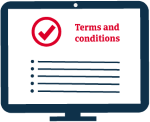|
|
In order to get paid, you'll need to do more than just delivering your goods or services. Things can get messy quickly if you don't watch out.
Getting your accounts receivable and invoicing process right doesn't only save you time, it also paves the way to being in control of your cash flow.
Here are 5 tips you can follow right away to have an efficient receivables and invoicing process:
1. Set clear payment terms |

|
Don't wait for invoicing problems, payment disputes, or late payments to happen. You can prevent them from happening by setting clear payment terms in advance.
To save time, you can set general payment terms first. Then negotiate the specific terms with each customer until both parties are on the same page.
Typical payment terms include:
- The payment amount for the goods or services you deliver
- When you will invoice your customer
- When your customer has to pay
- The payment method(s) your customer should use
Plus incentives and disincentives, depending on the situation of your business:
- The consequences of late payment (e.g. late fees, interest charges)
- The credit policies designed to discourage late payment (i.e. stop delivering goods or services until your customer pays all their outstanding invoices)
- The rewards for early payment (e.g. discounts)
It's important to spell out everything. Leave no room for guesswork.
After negotiating, you and your customer should document all the agreed payment terms in writing and sign off on them before doing any business.
This will serve as a legally binding document in your favour if your customer violates the terms.
2. Keep accurate records |

|
As you have more customers, you have more customer data to manage.
If you don't keep those records organised and up to date, you will lose track of what was agreed, what has been done, and what still needs to be paid.
Your data records of each customer should have:
- All the contracts made with the customer
- All the sales orders received from the customer
- The time you've spent on fulfilling the customer's orders
- The resources you've put into the customer's orders
- All the documents confirming the deliveries of your goods or services
- All the invoices sent to the customer, including the paid and unpaid ones
- When the customer has to pay each invoice
- All the communications with the customer about payments (e.g. reminders, agreements)
This may sound like a lot of work. But it doesn't have to happen all at once. You just need to keep records of each step taken as you go along. Many accounting software (e.g. FreshBooks, QuickBooks, Xero) can help you do this easily.
Storing all your customer data records in one place also has a great advantage. When something is missing or wrong, you will know immediately where to check first.
3. Offer easy payment methods |
|
You probably have a preferred payment method, so do your customers. It's necessary to choose the easiest payment methods for both parties.
When you make it easy for your customers to pay, they can pay quickly and have fewer excuses to delay payment.
When it's easy for you to receive and track payments, you can save the time spent on waiting and checking who has paid what.
Some common payment methods are:
- Credit cards
- Debit cards
- Direct debit
- Bank transfers
- Cheques
Tip: Choose electronic payments if possible. Supported by many online payment services, they make the payment process short and simple for your customers. They also make it easy for you to keep track of where payments come from.
4. Invoice on time and on point |

|
To reduce payment delays caused by invoicing, you'll need to make sure that each invoice:
- Meets the special requirements of the customer. Each customer is different, so check with them beforehand:
- Is there any extra information they want to see on the invoice?
- How do they want to receive the invoice?
Knowing all of this in advance is better than being caught by surprise later.
- Has all the correct information. Sometimes it's difficult to get the basics right. Ask yourself:
- Are the customer's name and address correctly written?
- Are the goods or services correctly listed?
- Is the invoiced amount correctly calculated?
- Is the due date correctly stated?
Then double-check.
- Includes the agreed payment terms, and the incentives to pay early and disincentives to pay late if applicable.
- Is sent on time. The customer will only pay after they receive the invoice. If there are no specific agreements on this, you can send the invoice as soon as you have delivered the goods or services.
5. Use online collections service |
|
The above tips can help you cut the number of outstanding invoices, but not all of them. It's always possible for your customers to pay late or not pay at all.
When this happens, you should contact the customers and find out why they haven't paid. Many things can happen from the moment a contract is signed to the moment the invoice is due.
If this takes too much of your time, or your efforts haven't resulted in payment, consider getting external help.
An experienced and professional collections agency with the right approaches can encourage your customers to pay, while maintaining your business relationships.
With Atradius Collections, you can use the online service to:
- Know right away how much it costs to collect your outstanding invoices. Get a free quote here.
- See real-time updates on the collections progress
- Get paid as soon as your customers pay their outstanding invoices
Being efficient is crucial for the profit of businesses.
Whether it is managing accounts receivable, invoicing, or collecting, do what you can, leave the rest to those who can help. Focus on growing your business.
